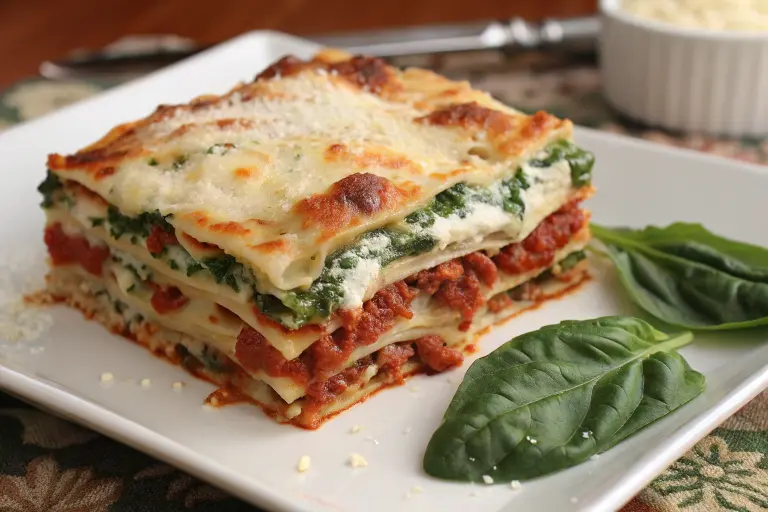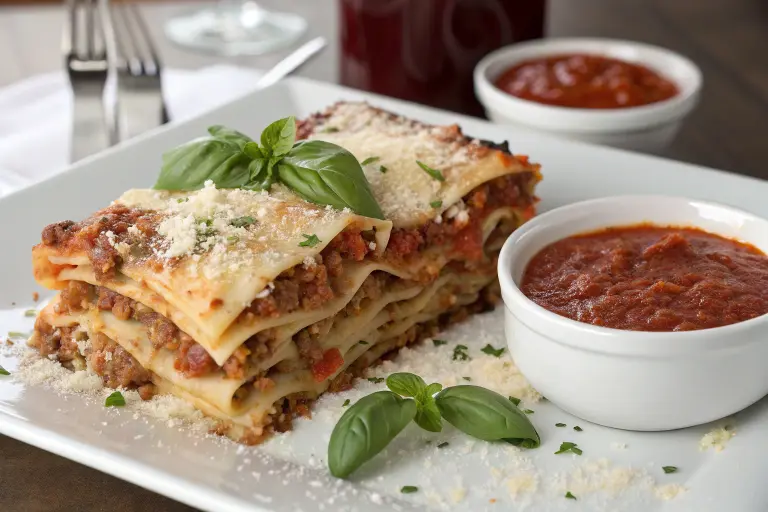Lasagna has long been a family favorite, offering a hearty and comforting meal that’s perfect for any occasion. But when it comes to making lasagna, there are many decisions to make. One of the most debated topics among home cooks is whether to use traditional boiled lasagna noodles or the more modern no-boil lasagna noodles. The question, “Should you use no-boil lasagna noodles?”, often arises when looking for a quicker and easier way to prepare this classic dish.
No-boil noodles have gained popularity in recent years, promising a faster preparation process without compromising flavor. But how do they stack up against their boiled counterparts? Is the convenience worth it, or will the texture and taste fall short of expectations? In this article, we’ll dive deep into the world of no-boil lasagna noodles, answer the burning question of whether you should use them, and explore everything from texture to taste to cooking time.
By the end of this guide, you’ll have all the information you need to decide whether no-boil lasagna noodles are the right choice for your next lasagna recipe. Let’s discover the pros, cons, and tips for making the most of these innovative noodles!
What Are No-Boil Lasagna Noodles?
No-boil lasagna noodles are a type of pasta that has been pre-cooked and dehydrated. Unlike traditional lasagna noodles, which require boiling before assembling the dish, no-boil noodles can go straight into the lasagna without the need for cooking. The idea behind these noodles is to save time and effort in the kitchen, making lasagna preparation faster and simpler.
How Do No-Boil Lasagna Noodles Work?
You might be wondering how these noodles can cook properly without boiling. The key is that they absorb moisture from the sauce during baking. When you layer them with your choice of sauce, cheese, and meat, the noodles soften as they bake, taking on the flavors of the dish.
It’s important to note that the sauce in your lasagna must be sufficiently moist for the noodles to cook properly. A dry sauce will result in hard, undercooked noodles, while a saucy mixture will make sure the noodles soften perfectly.

The Pros of Using No-Boil Lasagna Noodles
Using no-boil noodles has some significant advantages. While they may not be for everyone, many home cooks swear by them for various reasons. Here are some key benefits of choosing no-boil lasagna noodles:
1. Time-Saving Convenience
One of the biggest advantages of no-boil lasagna noodles is that they save you time. Traditional lasagna noodles require boiling and draining, which can add an extra 10-15 minutes to your prep time. With no-boil noodles, you can skip this step entirely, streamlining your cooking process.
2. Easier to Assemble
No-boil noodles can also make assembling the lasagna quicker and easier. There’s no need to worry about them sticking together or handling hot water. This can be especially helpful when you’re preparing lasagna for a large group or when you’re in a rush to get dinner on the table.
3. Less Mess and Cleanup
Since you skip the boiling process, you also avoid the mess associated with boiling water and draining noodles. This can make for a cleaner kitchen and fewer dishes to wash afterward.
4. Consistent Texture
When used correctly, no-boil noodles can yield a great texture in your lasagna. They tend to stay firm yet tender, absorbing the sauce’s flavors as they cook in the oven.
5. Ideal for Busy Weeknights
If you’re short on time but still want to enjoy a hearty, home-cooked meal, no-boil lasagna noodles can be a lifesaver. You can prepare the lasagna in advance, pop it in the oven, and have dinner ready quickly.
The Cons of Using No-Boil Lasagna Noodles
While there are clear benefits, no-boil noodles are not without their potential downsides. As with any product, it’s important to consider both the pros and cons before deciding.
1. Requires Sufficient Moisture
As mentioned earlier, the sauce must be moist enough for the no-boil noodles to cook properly. If your sauce is too thick or dry, the noodles may not cook all the way through, resulting in an unpleasant texture. If you’re not careful, you could end up with hard and chewy noodles.
2. Potential for Overcooking
Since no-boil noodles absorb moisture during baking, they can sometimes become too soft or mushy if the lasagna is baked for too long. It’s crucial to monitor the cooking time to avoid this problem.
3. Slightly Different Texture
Though no-boil noodles can yield a great texture when cooked correctly, some people find they are slightly different from traditional noodles. No-boil noodles may not be as firm as boiled noodles, which can be a turn-off for some people. If you prefer the classic, al dente texture of traditional lasagna noodles, no-boil noodles might not suit your liking.
4. Limited to Certain Recipes
No-boil noodles work best in recipes with a lot of sauce. If you’re making a lasagna with a drier filling, such as a vegetable lasagna with minimal sauce, no-boil noodles might not perform as well. In these cases, traditional noodles might be a better choice.
Should You Use No-Boil Lasagna Noodles for Your Lasagna?
Now that we’ve discussed the pros and cons, you’re probably wondering, should you use no-boil lasagna noodles? The answer depends largely on your preferences and the type of lasagna you’re making.
When No-Boil Lasagna Noodles Are a Good Choice
- Busy Weeknights: No-boil noodles are a great option if you need a quick, easy dinner. They save you time and effort.
- Heavily Sauced Lasagna: If your lasagna has plenty of sauce (whether it’s marinara, béchamel, or a combination of both), no-boil noodles will work perfectly.
- Meal Prep: If you would like to prepare your meals in advance, no-boil noodles can be assembled much faster. Simply assemble, refrigerate, and bake when you’re ready.
When to Avoid No-Boil Lasagna Noodles
- Dry or Thick Sauces: Traditional lasagna noodles may be a better choice if your sauce is too thick or not very saucy.
- Personal Preference: If you prefer a firmer texture, you might want to stick with traditional boiled noodles, as no-boil noodles tend to be softer.
How to Use No-Boil Lasagna Noodles Correctly
If you’ve decided to give no-boil lasagna noodles a try, here’s how to use them properly to achieve the best results:
- Use a Moist Sauce: Ensure your sauce has enough moisture to cook the noodles. You can always add extra liquid to the sauce if it’s too thick.
- Layer Generously: Be sure to evenly layer your sauce, cheese, and meat. The noodles should be fully covered with sauce to absorb moisture and cook properly.
- Cover with Foil: When baking, cover your lasagna with foil for the first 30 minutes. This traps steam and ensures the noodles cook through. Afterward, remove the foil for the top to brown and crisp up.
- Monitor Baking Time: No-boil noodles can cook quickly, so be sure to check the lasagna periodically to avoid overcooking the noodles. A good rule of thumb is to bake for 45 minutes to 1 hour, depending on your recipe.
Alternatives to No-Boil Lasagna Noodles
If you’re not convinced by no-boil noodles, there are several alternatives you can consider:
1. Traditional Boiled Lasagna Noodles
Traditional lasagna noodles require boiling before use. They’re widely available, and many people prefer them for their firm, classic texture. If you’re not in a rush and enjoy the process of making lasagna, this option might be ideal for you.
2. Gluten-Free Lasagna Noodles
If you or someone in your family is gluten intolerant, gluten-free lasagna noodles are a good alternative. Many brands offer gluten-free options that are similar to traditional noodles but without the wheat.
3. Zucchini or Eggplant Noodles
You can substitute zucchini or eggplant slices for a lighter, low-carb option for lasagna noodles. These vegetable-based alternatives provide a fresh twist on traditional lasagna and are great for those following low-carb or keto diets.

FAQs: Should you use no-boil lasagna noodles?
❓ Why Are My No-Boil Lasagna Noodles Not Softening?
No-boil lasagna noodles need enough moisture to soften properly. If your sauce is too thick or dry, the noodles won’t absorb enough liquid to cook. Ensure your sauce is saucy and covers the noodles completely.
❓ What Is a Good Substitute for Lasagna Noodles?
If you’re looking for a low-carb alternative, zucchini or eggplant slices can be great substitutes. Gluten-free lasagna noodles are also available for those with dietary restrictions.
❓ Do You Need to Pre-Cook Dry Lasagna Sheets?
No, dry lasagna sheets don’t need to be pre-cooked when using no-boil noodles. However, they must be layered with enough sauce to soften while baking.
❓ How to Prevent Lasagna Noodles from Sticking Together?
To prevent sticking, make sure the noodles are fully coated with sauce and avoid overcrowding them. For traditional noodles, lightly oil the water before boiling, and stir occasionally.
Conclusion: Should you use no-boil lasagna noodles?
In conclusion, “Should you use no-boil lasagna noodles?” truly depends on your preferences, cooking style, and the specific recipe you’re preparing. No-boil lasagna noodles are a fantastic option for anyone looking to save time and simplify the cooking process. They are especially ideal for busy weeknights or meal prepping, where convenience is key. However, if you prefer the traditional texture of boiled noodles or if your lasagna relies on a drier sauce, sticking with the classic option might be better.
Whatever noodle type you choose, the ultimate goal is to create a delicious and satisfying lasagna. The key is to ensure you layer your ingredients well, keep the sauce moist, and monitor your baking time to achieve the perfect balance of flavors and textures. So whether you’re a fan of no-boil noodles or prefer to cook your lasagna the traditional way, both options can lead to a tasty, homemade meal.
Check out some of our other popular recipes for more creative and easy dinner ideas. You might enjoy our Chicken Alfredo Soup with Beef and Parmesan Cheese, a rich and hearty dish that’s sure to warm your family’s heart. Or, if you’re craving another comforting soup, try our Alfredo Chicken Noodle Soup for a satisfying meal that combines tender chicken with a creamy Alfredo base.
Also, for more great cooking tips, follow us on Chaynez Recipes for easy access to our social media and other exciting recipes. You can also visit our website at Chaynez Recipes for even more delicious, easy-to-follow recipes that will improve your cooking game!






